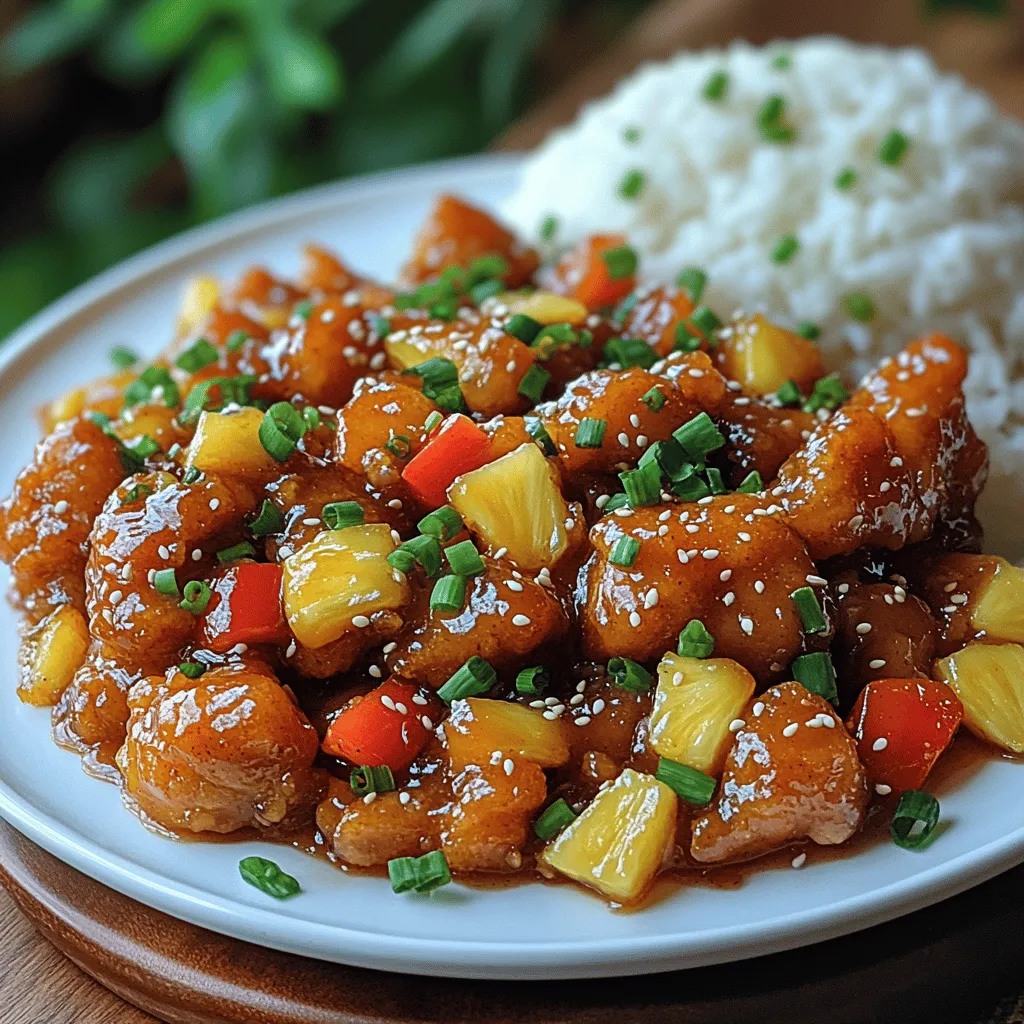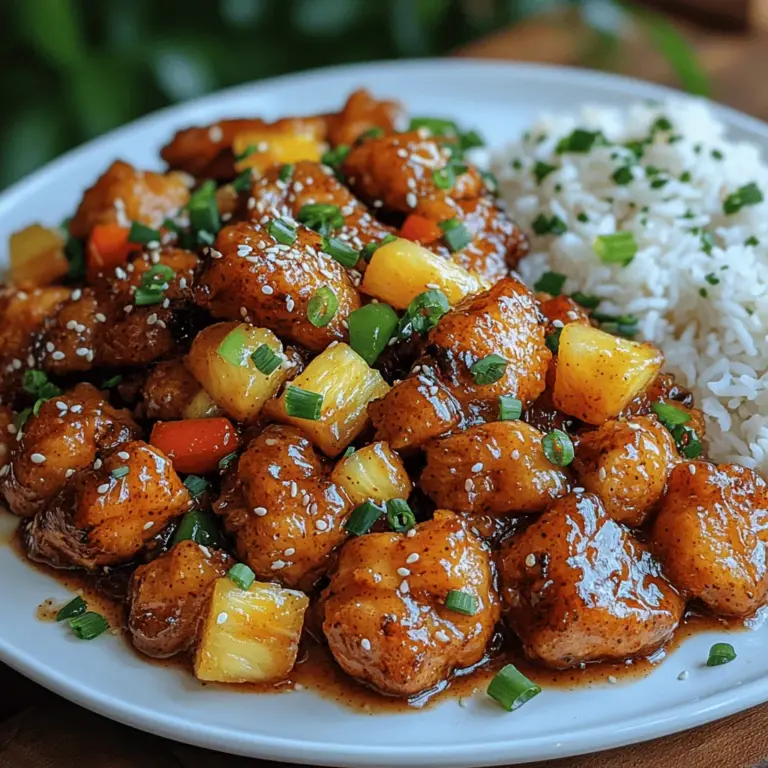Introduction
Tropical Sweet and Sour Chicken is a vibrant and flavorful dish that transports your taste buds to an island paradise with every bite. Combining tender pieces of chicken with the refreshing sweetness of pineapple and a tangy sauce, this dish encapsulates the essence of tropical cuisine. The sweet and sour flavor profile has gained popularity across various cuisines around the world, from Chinese takeout classics to Caribbean-inspired meals, making it a beloved choice among food enthusiasts.
One of the best aspects of this recipe is its simplicity and accessibility. With easily sourced ingredients and straightforward steps, even novice cooks can create a stunning dish that is perfect for weeknight dinners or special gatherings. Whether you’re looking to impress guests or treat your family to something special, Tropical Sweet and Sour Chicken is a delightful option that offers a balance of flavors and textures, all while being fun to prepare.
Understanding the Ingredients
Chicken
At the heart of this dish is the chicken, which serves as the primary protein. For the best results, it’s essential to use boneless, skinless chicken breasts. This cut of meat not only offers tenderness but also absorbs the flavors of the sauce beautifully without becoming too greasy. When cooked properly, chicken breasts can remain juicy and flavorful, making them the perfect canvas for the vibrant sweet and sour sauce.
Sweet and Sour Sauce
The star of the show is undoubtedly the sweet and sour sauce, which harmonizes the dish’s flavors. The key ingredients that create this unforgettable profile include ketchup, vinegar, and brown sugar. Ketchup provides a rich tomato base, while vinegar adds a necessary tang that cuts through the sweetness. Brown sugar, known for its deep caramel notes, enhances the sauce’s overall flavor, creating a delightful contrast.
In addition to these core components, honey and soy sauce play a significant role in rounding out the sauce. Honey contributes a natural sweetness and helps to thicken the mixture, while soy sauce adds a savory umami depth that balances the flavors.
Vegetables
To achieve a vibrant and nutritious dish, a medley of vegetables is incorporated. Bell peppers, onions, and pineapple not only add color but also enhance the dish’s nutritional profile. Bell peppers bring a crisp texture and a burst of sweetness, whereas onions provide a subtle sharpness. Pineapple, the quintessential tropical fruit, infuses the dish with its juicy, sweet flavor, perfectly complementing the savory elements of the chicken and sauce. Together, these vegetables create a colorful and appetizing presentation that is as pleasing to the eye as it is to the palate.
Preparation of the Chicken
The preparation of the chicken is a crucial step in ensuring that your Tropical Sweet and Sour Chicken turns out perfectly. Start by ensuring that your chicken breasts are thoroughly cleaned and pat them dry with paper towels. This step is essential as it helps the seasonings adhere better and prevents excess moisture from affecting the cooking process.
Seasoning
To build a flavorful base, generously season the chicken with salt and pepper. This simple seasoning enhances the natural flavor of the chicken and sets the stage for the sweet and sour sauce that will later envelop it. Allow the seasoned chicken to rest for about 10-15 minutes, enabling the flavors to penetrate the meat.
Dredging Process
Next, it’s time to prepare the chicken for frying. The dredging process is vital for achieving a crispy texture. Start by setting up a dredging station with two shallow dishes. In the first dish, place cornstarch, and in the second, whisk together a couple of eggs until well beaten.
Take each piece of seasoned chicken and first coat it in cornstarch, ensuring it is evenly covered. The cornstarch not only helps to create a crispy crust but also aids in moisture retention during cooking. After dredging in cornstarch, dip the chicken into the beaten eggs, allowing any excess to drip off. The egg acts as a binding agent, ensuring that the cornstarch adheres well to the chicken.
Frying the Chicken
When it comes to frying, the temperature of the oil is key. Heat a large skillet or wok over medium-high heat and add enough oil to coat the bottom. The ideal temperature for frying chicken is around 350°F (175°C). You can test the oil’s readiness by dropping a small piece of the dredged chicken into the oil; if it sizzles immediately, you’re ready to start frying.
Carefully place the chicken pieces into the hot oil, making sure not to overcrowd the pan. Fry in batches if necessary to maintain the temperature of the oil. Cook the chicken for approximately 5-7 minutes on each side or until it turns golden brown and crispy. Using a slotted spoon, remove the chicken from the oil and place it on a plate lined with paper towels to absorb any excess oil. This step ensures that the chicken remains crispy and not greasy.
Crafting the Sweet and Sour Sauce
Once your chicken is fried to perfection, it’s time to craft the sweet and sour sauce that will elevate your Tropical Sweet and Sour Chicken to new heights. Making this sauce is straightforward and requires just a few simple ingredients.
Ingredients Breakdown
In a medium saucepan over medium heat, combine equal parts ketchup and vinegar. The ketchup provides the sweet base, while the vinegar adds the necessary acidity. Next, add brown sugar, stirring until it dissolves completely into the mixture. This combination creates a harmonious balance of flavors.
To further enhance the sauce, add a drizzle of honey and a splash of soy sauce. The honey will add an extra layer of sweetness and help thicken the sauce, while the soy sauce infuses it with a savory depth.
Adjusting Flavors
As you simmer the sauce, taste it and adjust the flavors to your preference. If you like it sweeter, add more honey or brown sugar. For those who enjoy a bit of heat, consider adding a pinch of red pepper flakes or a splash of hot sauce. This flexibility allows you to customize the sauce to suit your palate and the tastes of those you are serving.
Simmering the Sauce
Allow the sauce to simmer for about 5-10 minutes, stirring frequently. This will help meld the flavors together and thicken the sauce slightly. Once it reaches your desired consistency, remove it from the heat and set it aside while you prepare the vegetables.
Stir-Frying the Vegetables
The final step in this delightful recipe is to stir-fry the vegetables, which will add a fresh crunch and vibrant color to the dish. Begin by slicing the bell peppers and onions into bite-sized pieces, and have your pineapple ready to go.
Sautéing Instructions
In the same skillet used for frying the chicken, add a bit more oil if necessary and return it to medium-high heat. Once hot, add the sliced onions and bell peppers first. Stir-fry for about 2-3 minutes until they begin to soften but still retain some crunch.
Next, add the pineapple chunks, allowing them to caramelize slightly and release their juices. This step enhances the sweetness of the dish and melds beautifully with the other ingredients.
Combining Ingredients
After the vegetables have been sautéed to your liking, it’s time to incorporate the fried chicken back into the skillet. Pour the prepared sweet and sour sauce over the chicken and vegetables, tossing everything together to ensure an even coating. The combination of tender chicken, crunchy vegetables, and the luscious sauce creates a stunning medley of flavors and textures that is sure to impress.
With the Tropical Sweet and Sour Chicken prepared and beautifully plated, you are ready to serve this mouthwatering dish to your family and friends, bringing the taste of the tropics right to your dining table.

Importance of Cooking Time for Each Vegetable
When preparing Tropical Sweet and Sour Chicken, timing is crucial to ensure that each vegetable retains its unique texture while contributing to the overall flavor profile of the dish. Bell peppers, for instance, should be stir-fried just until they are tender-crisp, preserving their bright color and crunchy bite. If overcooked, they can become mushy and lose their vibrant appeal.
Carrots, on the other hand, require a slightly longer cooking time due to their density. Slicing them thinly can help them cook more evenly and quickly. By adding carrots to the pan first, you allow them to soften slightly before introducing quicker-cooking vegetables like snap peas or pineapple. This careful attention to cooking times will enhance the final presentation and mouthfeel of your dish.
The role of garlic and onion in building a flavor base cannot be overstated. As you sauté these aromatics at the start of the cooking process, they release essential oils and flavors that form a robust foundation for the sweet and sour sauce. Aim to cook them until they are translucent and fragrant, but be careful not to burn them, as this can impart a bitter taste to your dish.
Incorporating Pineapple for That Quintessential Tropical Taste
The pineapple is the star ingredient in this recipe, lending its sweet and tangy flavors that define a traditional sweet and sour dish. For the best results, use fresh pineapple if possible; it offers a juiciness and brightness that canned versions may lack. If using canned pineapple, make sure to drain it well to avoid excess liquid in your dish.
To incorporate the pineapple, cut it into bite-sized chunks that mirror the size of the chicken and vegetables. This will ensure a balanced bite every time. Add the pineapple towards the end of cooking to maintain its structure while allowing it to warm through and caramelize slightly, enhancing its natural sugars and flavor.
Bringing It All Together
Once your chicken is fried to perfection and the vegetables are stir-fried and vibrant, it’s time to bring everything together. Start by preparing the sweet and sour sauce, which typically includes a combination of vinegar, sugar, soy sauce, and sometimes ketchup or pineapple juice for added depth. This sauce is what will elevate your dish and provide that signature flavor.
To combine the fried chicken and sauce with the stir-fried vegetables, first, add the sauce to the pan with the vegetables. Allow it to simmer for a minute to thicken slightly before adding the chicken. This helps ensure that every piece of chicken is coated evenly with the sauce, enhancing the overall flavor. Use tongs or a spatula to gently toss everything together, making sure that the chicken and vegetables are well mixed and every component is glazed with the sweet and sour sauce.
Simmering the dish for a few minutes after combining will not only meld the flavors but also allow the chicken to absorb some of the sauce, creating a harmonious blend of sweet and savory. This final step is crucial; it’s where the magic happens, transforming the individual components into a cohesive dish that bursts with flavor.
Garnishing and Serving Suggestions
Presentation is key when it comes to serving Tropical Sweet and Sour Chicken. To enhance the visual appeal, consider garnishing the dish with freshly chopped green onions and a sprinkle of sesame seeds. These garnishes add a pop of color and a slight crunch that complement the dish’s texture perfectly.
When it comes to serving, this dish pairs beautifully with steamed white rice or fried rice, providing a perfect balance to the sweet and tangy flavors. The rice acts as a neutral base, soaking up the excess sauce and allowing the vibrant flavors to shine. Alternatively, consider serving it alongside a fresh cucumber salad or sautéed bok choy for added texture and a refreshing counterpart to the warmth of the chicken.
Nutritional Information
Tropical Sweet and Sour Chicken not only delights the palate but also offers several nutritional benefits. The chicken provides a solid source of protein, vital for muscle repair and growth, while the colorful array of vegetables contributes essential vitamins and minerals. Bell peppers are rich in vitamin C, carrots provide beta-carotene, and snap peas add fiber and protein, making this dish a well-rounded option.
Additionally, pineapple offers digestive benefits thanks to its natural enzymes and is also a source of antioxidants. When considering portion control, aim for a balanced plate that includes a healthy serving of protein, vegetables, and carbohydrates. This approach promotes healthy eating habits while still allowing you to enjoy the flavors of this tropical dish.
Cultural Context and Variations
The origins of sweet and sour dishes can be traced back to various global cuisines, with roots in Chinese cooking that have been adapted and embraced worldwide. The balance of sweet and tangy flavors creates a unique dining experience, making it a favorite in many households.
For those with dietary preferences, there are numerous variations of Tropical Sweet and Sour Chicken to explore. For a vegetarian option, consider substituting the chicken with tofu or tempeh, marinated and fried for a similar texture. Gluten-free adaptations can easily be made by using tamari instead of traditional soy sauce, ensuring that everyone can enjoy this delicious dish.
Conclusion
In summary, Tropical Sweet and Sour Chicken is not only a feast for the senses but also a straightforward recipe that can bring joy to your kitchen. With its vibrant colors, tantalizing flavors, and ease of preparation, this dish is perfect for family dinners or gatherings with friends. The combination of tender chicken, crisp vegetables, and sweet pineapple creates a symphony of tastes that is sure to please.
We encourage you to try out this recipe and experience the delight of cooking and sharing a meal with loved ones. Whether you’re a seasoned chef or a beginner in the kitchen, this dish has the potential to become a family favorite or a standout at any gathering. Indulge in the tropical flavors and let the joy of cooking bring you and your loved ones together around the table.

